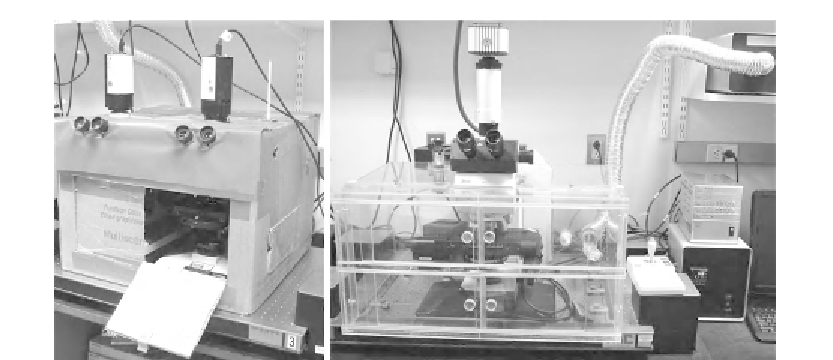Biomedical Engineering Reference
In-Depth Information
(A)
(B)
Figure 3.1
(A) Microscope enclosure made from a cardboard box. The box has cuts to provide “doors” to
access the stage area, focus knobs, and the photochanger headpiece of the microscope. Eye
pieces and the camera are not enclosed inside the box. For microscopes with a tungsten
illuminator being run at moderate voltages, the illuminator can be left inside the box. (B) Plexiglas
enclosure for an upright microscope with slider doors which allow access to the stage, switches,
and other controls. The round “buttons” on the front of the enclosure are the handles for the
slider doors. The microscope and the enclosure are on a vibration isolation table that has a
“bread board” surface with tapped holes for screws. The enclosure is made in three pieces (front
and two sides) that are held down with metal tabs that are held with bolts screwed into the top
of the anti-vibration table. Also visible in the upper right corner of the image is the heater unit
with an aluminum air duct going to the enclosure.
lower on the front to give access to the microscope switches and other controls
(
Figure 3.1B
). For those who do not have the ability to have enclosures made, all major
microscope manufacturers and independent suppliers offer Plexiglas enclosures that cover
the upper portions of their microscopes. We cover the entire microscope because this keeps
the stand at a constant temperature thereby obviating the otherwise inevitable changes in
specimen position and focus if the room temperature changes. In addition, we can readily
switch between lower and higher magnification immersion objectives without the bother of
using objective heaters and changing the wiring from one lens heater to the other. We run
the temperature control systems continuously; this allows us to put cell preparations on the
microscope on short notice without having to wait for the microscope to warm up and
become dimensionally stable. Also, the lack of temperature cycling reduces the chances that
the glass in the condenser and objective lenses will become strained. Strain in the optics
degrades the extinction, and hence contrast, for polarizing and DIC microscopes.
To heat the microscope enclosure one can buy heater/control systems integrated into a
single box (e.g., the “Air-Therm ATX” from World Precision Instruments Inc., Sarasota,

Search WWH ::

Custom Search